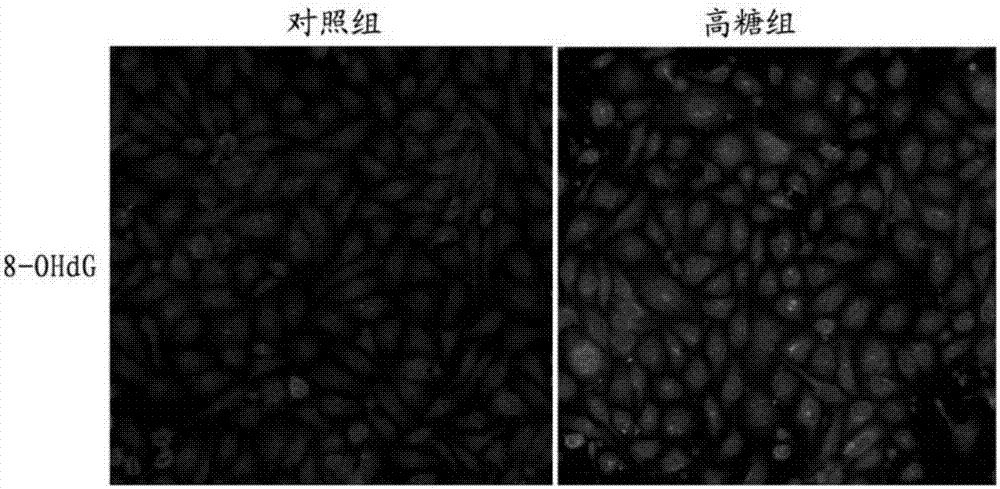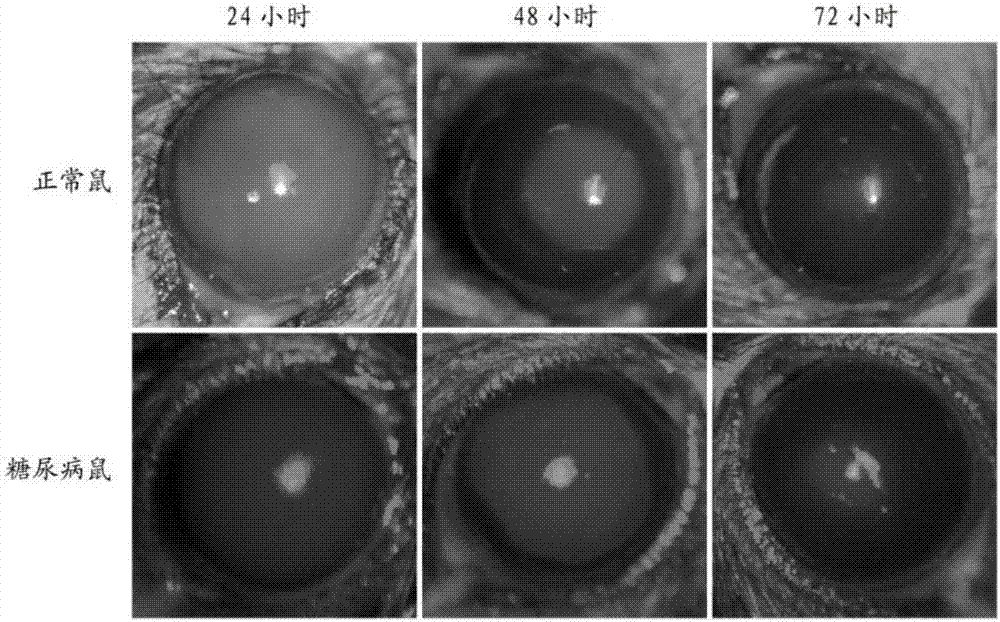Application of manganese benzoate porphyrin in preparation of medicine for promoting diabetic corneal injury healing
A technology for manganese benzoic acid and corneal damage, applied in the field of biomedicine, can solve the problems of poor curative effect, slow effect, long treatment period, etc., and achieve the effects of repairing corneal damage, improving GSH level, and promoting corneal epithelial damage repair.
- Summary
- Abstract
- Description
- Claims
- Application Information
AI Technical Summary
Problems solved by technology
Method used
Image
Examples
Embodiment 1
[0032] TKE2 cells were conventionally cultured with KSFM medium (purchased from Invitrogen, USA), and 1×10 5 Inoculate cells into a six-well plate, select one well as a control, add 1mol / L mannitol and 30μl / ml cell solution to one well as the osmotic pressure control group, and add 1mol / L glucose and 30μl / ml cell solution to the other two wells , and at the same time add 50mmol / L MnTBAP 2μl / ml cell solution in one group of glucose treatment wells, so that the final concentration of MnTBAP is 100μM, and then in 5% CO 2 and cultured at 37°C. After 3 days, 50,000 cells were collected and incubated at 37°C for 20 min with a culture medium containing 5 μM fluorescent probe DCHF-DA (purchased from Molecular Probes, USA), and then used a microplate reader (model SpectraMaxM2, MolecularDevices, USA) measure the fluorescence intensity, that is, the ROS level.
[0033] A batch of cells treated in the same way was detected by JC-1 kit (purchased from Beyond, China) combined with flow cy...
Embodiment 2
[0037] Corneal epithelium damage repair and 8-OHdG expression in diabetic mice induced by streptozotocin (STZ, purchased from Sigma, USA).
[0038] Six STZ-induced adult C57BL / 6 diabetic mice and age-matched control mice (C57BL / 6 normal mice) were used to scrape the epithelium in the central 3mm area of the right cornea of the mouse with a 3mm trephine drill and an epithelial scraper, respectively. After 24, 48 and 72 hours, 0.25% sodium fluorescein was added dropwise to the cornea, and the cornea was observed and photographed under the slit lamp.
[0039] The result is as image 3 As shown, the staining of sodium fluorescein in the epithelial defect area is green, and the corneal epithelium of normal mice has healed 72 hours after injury, while the corneal epithelium of diabetic mice has not healed, which shows that in normal C57 mice and STZ-induced diabetic mice , after establishing the corneal epithelial scraping injury model, the corneal epithelial healing speed of d...
Embodiment 3
[0043] Effects of MnTBAP on the repair of STZ-induced corneal epithelial injury in diabetic mice
[0044] Twelve STZ-induced C57BL / 6 diabetic mice were randomly divided into a control group (diabetic mice) and a treatment group (diabetic mice + manganese benzoate porphyrin), and the central cornea of the right eye of the mice was scraped using a 3 mm trephine drill and an epithelial spatula. Epithelium in the 3mm region, 7μl of 50mmol / L MnTBAP injected subconjunctivally in the right eye of the mice in the treatment group (mouse body weight is 25g), and 7μl PBS injected subconjunctivally in the right eye of the mice in the control group. After 72 hours, staining with sodium fluorescein and taking pictures under a slit lamp were used to observe the repair of epithelial damage in mice in each group.
[0045] The repair of epithelial injury in each group of mice was as follows: Figure 5 As shown, the fluorescein sodium staining area is the epithelial defect area, and it can be...
PUM
 Login to View More
Login to View More Abstract
Description
Claims
Application Information
 Login to View More
Login to View More - R&D
- Intellectual Property
- Life Sciences
- Materials
- Tech Scout
- Unparalleled Data Quality
- Higher Quality Content
- 60% Fewer Hallucinations
Browse by: Latest US Patents, China's latest patents, Technical Efficacy Thesaurus, Application Domain, Technology Topic, Popular Technical Reports.
© 2025 PatSnap. All rights reserved.Legal|Privacy policy|Modern Slavery Act Transparency Statement|Sitemap|About US| Contact US: help@patsnap.com



